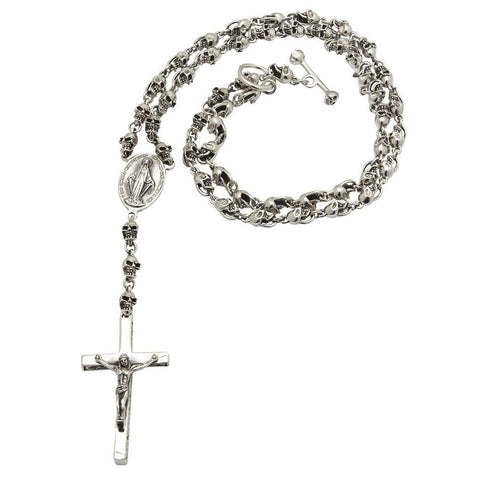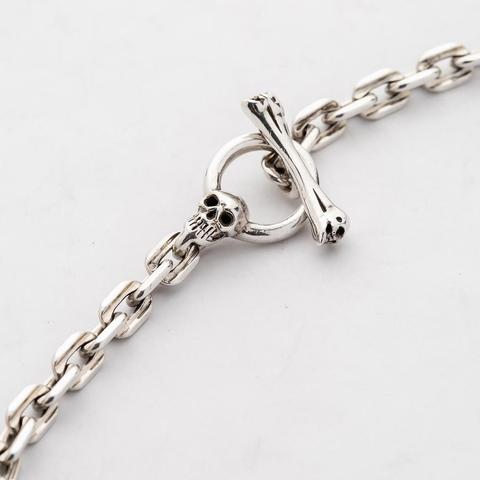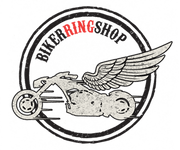When being in the market for a men’s necklace, its design isn’t the only thing worthy of consideration. You should pay the utmost attention to a material it is made of, construction, and maille weave since these things contribute to a necklace’s durability. You surely want everything to be fine in this department. Below, we are going to focus on the most critical aspects of men’s around the neck jewelry to help you find a lasting piece.
A Solid or Hollow Chain?
This is among the most critical points that need to be considered before purchasing a product. As you probably already know, hollow chain necklaces are much lighter than their solid counterparts. At the same time, they may look thicker and bigger. Such pieces carry affordable prices and delight with fancy weave types. Nevertheless, hollow chain necklaces have an obvious drawback - their durability. Or rather, the lack thereof. Lightweight products tend to deform and tear faster. They are simply unsuitable for everyday wear and its rigors.
Needless to say, pieces made of solid metal feel heavier on your neck and your wallet. But when it comes to their sturdiness, it’s as good as it gets. They are much harder to break, tear, or deform. If you happen to disconnect or damage a few links, a good jeweler will be able to fix them and restore the original look of your necklace.
Chain Necklace Production Methods
Chain necklaces are made both by people and machines. Mass production technologies utilize workpieces that are placed in special machines. These pieces of equipment bend silver or gold wire to make links and connect them into a chain.
If an item is made by hand, everything (except the quality of precious metal) depends on the skill and dexterity of a jeweler. Crafting a chain using only hand tools is a painstaking process; that’s why these pieces carry a lofty price. The whole manufacturing process has four steps:
- An artisan draws wire and winds it around a reel;
- Silver or gold wire is cut into small pieces to make links;
- Links are given their shape and interconnected with pliers;
- Links are soldered and put under a press to obtain a flat look.
There is one more method to craft chains - stamping. In this case, links are made by a machine and an artisan just connects them with one another. Such pieces of jewelry are cheaper than hand-made ones but their strength and durability are on the same level.
Metal or Leather?
Bikerringshop supplies metal and leather necklaces alike. Which one to choose? The one that looks great personally for you! Subjective matters aside, metal pieces are much more durable than leather counterparts, of course, if they are manufactured properly. On the other hand, leather models feature lighter weight. Both types are not deprived of pros and cons, and we are going to single out some of them below.

Metal chains pros:
- strong and hard to tear;
- look expensive;
- come in a variety of weave types;
- can hold a large pendant;
- suitable for everyday wear;
- repairable;
- don’t corrode when being exposed to damp environments, body lotions, sweat, sebum, etc.
Metal chains cons:
- hefty;
- cost more;
- everyone has one.
Please keep in mind that all these points concern men’s necklaces crafted by Bikerringshop. Surely, there are plenty of delicate lightweight pieces but they are not our forte. Our online store supplies men’s necklaces made of silver and brass. Both metals are prone to tarnishing but you can easily remove it with a special wiping cloth or soapy water.

When it comes to leather necklaces, we have a few models to offer. But before you click the Buy button, make sure to take a look at their pros and cons:
Leather Necklaces Pros:
- lightweight;
- available in a variety of colors;
- ensure a down-to-earth look.
Leather Necklaces Cons:
- can’t hold a heavy pendant;
- not many weave types (most commonly, they are braided);
- less durable;
- change their color and mechanical properties over time.
Leather necklaces are not for everyday wear. Strictly speaking, you may rock them daily but you should follow a few safety rules such as don’t let them contact with water, sweat, or body care products.
Chain Maille Weaves
Cable Chain
Links of such a weave are similar in appearance and attachment method to an anchor chain. The first, third, and the following odd links are located in the same plane while the second, fourth, and other even ones are perpendicular to the former. This is a fairly simple but very strong weave for men's and women's chain jewelry. As a rule, cable chain necklaces accommodate all sorts of pendants, although they are also great as a standalone body ornament.

Fancy Chains
The links in these chain necklaces are unlike anything else. They are assembled from links of all kinds, shapes, and sizes. They may resemble dragon scales, bones, skulls, crowns, and so on. Such a design is the best bet for vibrant individuals who do not want to settle for things others have.

Cuban/ Curb / Gourmete
The links in this case are flat and smooth from the front and back sides alike. When being attached to each other, they form a single plane. Imagine what a chain mail looks like: the rings fit very tightly to each other creating the feeling of a canvas. A similar design is used when crafting a Cuban chain. The difference, however, is that each link is rather thick and it sits close to its neighbors. As a result, you can benefit from a flat chain that is convenient to wear around the neck. It fits snugly to the body and it does not twist or bend.

Ball chain/ Pelline chain/ Bead chain
Instead of traditional links, this weave offers beads that resemble a string of pearls. These balls can be solid or hollow. Either way, it doesn’t impact a chain’s durability, just adds or reduces its weight. Ball chains are available in two types: one of them displays balls connected with a visible thread/rod and the other has balls sitting closely to one another.
It is fairly difficult to pair these necklaces with a pendant or medallion. More often than not, they are worn as a standalone, rather long piece of jewelry. Visually, ball chain necklaces seem fragile but the look is deceptive – they are one of the strongest weave types around.

Bike Chain Weaving
Inspired by the iconic bicycle chain, this weave is perfect to add more edge to your look. Its mechanical appearance resembles gears that adorn your neckline. Bicycle chains are made durable so are these pieces of jewelry. Although they don’t thoroughly follow the design of the original bike chains (because you don’t a burden on your neck), their look will warm the heart of every avid motorcycle enthusiast.

Cascade
Cascade chains are comprised of a couple of intertwined ropes or wires. Basically, they are made to resemble a rope – these chains are round, don’t have any visible gaps, and showcase a twisted texture. Some cascade chains are flexible while others are rigid (the latter boast a formidable thickness and are oftentimes used in bracelets). In any case, cascade weave jewelry is very durable and industrial-looking.

Coffee bean chain
This chain looks exactly how it sounds. Its links resemble large metal coffee beans with two holes at each end. The shape of these links is not necessarily round-ish but its design always has a middle bar. While coffee bean links are placed horizontally, they are connected by smaller oval links that sit in the vertical plane. Some links are solid but more often than not, they are hollow to reduce the overall weight.

An anchor chain maille weave is similar to coffee beans. The difference is that all its links feature a more or less the same size and a vertical bar in the middle.
Clasps for Your Necklace
If you have already decided on the type of chain maille weaves, it's time to scrutinize a clasp. This small element is not inferior in importance to weave type and metal. Types of clasps are very different in design and your task is not only to check the workmanship but also consider the ease of use. Ideally, you should be able to fasten and undo a clasp without any assistance.
The jewelry industry offers these two the most popular clasp designs:
- Lobster clasp - a small hinge with a spring-loaded lock that snaps into place when it is threaded through a look;

- Spring ring clasp - a small round design with a spring mechanism.

Traditionally, a lobster clasp accompanies massive and hefty items. For elegant, thin, and almost weightless necklaces, a spring ring clasp would be a more appropriate option. Both of these fasteners are subject to repair if necessary and, in general, extremely reliable. That being said, they are not without drawbacks. For example, a large lobster clasp will stick out like a sore thumb when being combined with a delicate openwork necklace. At the same time, it will do a nice job of holding a massive pendant. A spring ring clasp, on the other, is a bad choice for heavy pendants but it is up to the task when it comes to completing dainty neck pieces.
In addition to these types of clasps, which you will find in 80% of necklaces, there are many other options that differ in weight, reliability, and appearance.
A Toggle clasp has two pieces – a T-shaped bar and a large loop. To close this clasp, you need to put a T-bar into the loop. This design is ideal for adding decorative features. T-bars are often embellished with gemstone inlays, engraving, embossing, or miniature sculptures such as these skull heads. Loops tend to carry relief designs and engraving. While a toggle clasp is easy to use, it is not the most secure around.

Open Box clasp consists of two parts - a box and wedge-shaped piece. The latter goes into the box and compresses till you hear a click. To open suck a clasp, there is a lever on the wedge that lets it slide out. Normally, an open box clasp is pretty large especially if it has to secure a heavy necklace. The main benefit of such a design is that you can open and close it with one hand. On the downside, repeated use may damage the wedge and it will cease to close securely. We recommend opting for an open box clasp for items you don’t wear regularly.

Fishhook clasp – one of the halves of this closure is a metal hook and the other is an oval or round loop. Some hooks may have a spring mechanism but more often than not they are just a curved piece of metal. This design is super simple and reliable since there is not much that can break or wear out. The drawback of the fishhook clasp is that it is relatively difficult to operate with one hand. Plus, if a hook becomes looser it security may be compromised.

S-hook clasp. Its design is similar to that of fish hooks. One end of the S-shaped hook is affixed to a chain and the other is supposed to go through a loop on the opposite side of a jewelry piece. Such clasps are pretty lightweight and easy to use but they can’t boast the utmost security. Once in a while, you may need to squeeze the hook so that it doesn’t come undone.

Watchband (fold-over) clasp –it is frequently incorporated into bracelets although you can sometimes find it in thick necklaces. This is a fairly large and heavy clasp and it can be easily opened and closed with a single hand. Thanks to its increased size, it often bears various designs, which may even become a focal point of a piece. Last but not least, watchband clasps are one of the most secure constructions, although they may wear out with time.

Now that you know which things to look out for when choosing a men's necklace, you'll be able to find a piece meeting all your expectations. Happy shopping.
P.S. Make sure to check out Bikerringshop necklace catalog.

